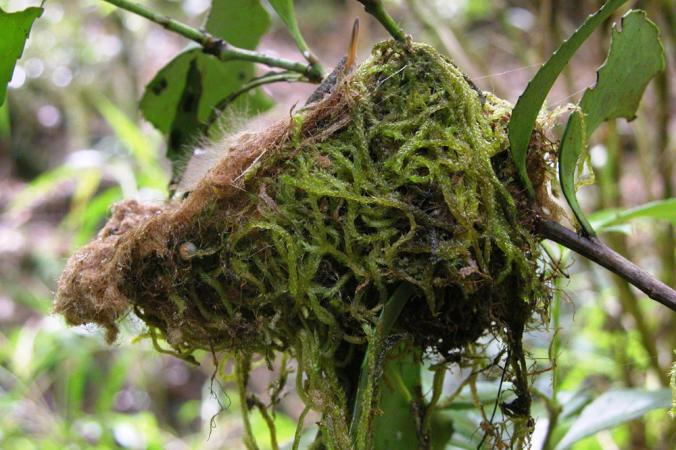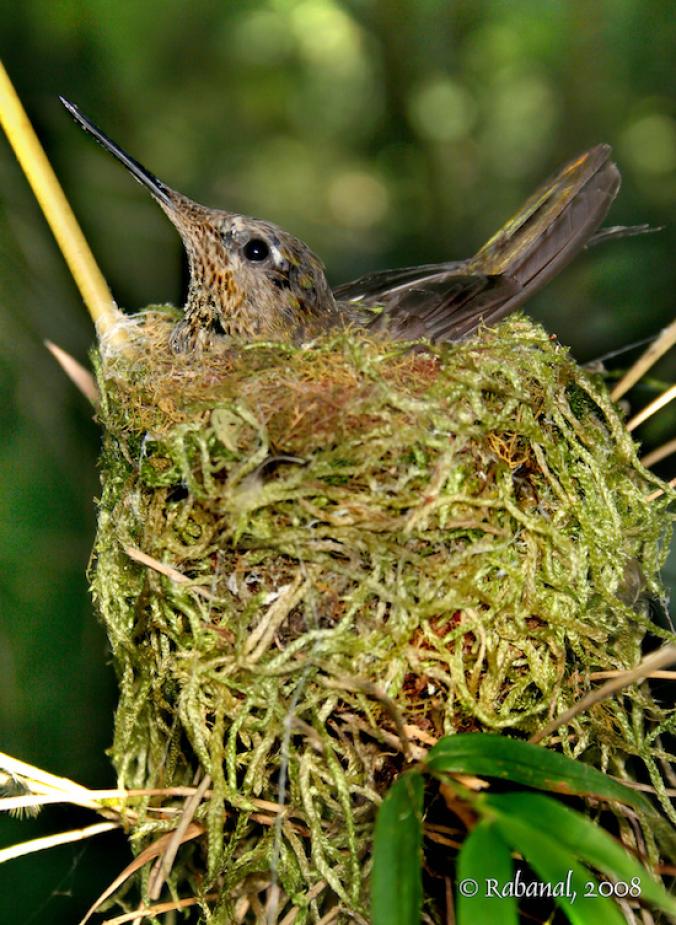
When we think of a nest, we think simply of a natural piece of construction. A bird gathers together twigs and stems and leaves and assembles them into a shelter for its eggs. We don’t think much about the plants it uses. They’re just building material.
But in at least some cases, there may be more to a nest than meets the eye. It may be a cooperative breeding project, produced by two partners–animals and plants.

Francisco Fonturbel, an ecologist at the University of Chile, and his colleagues study the green-backed firecrown hummingbird, the range of which stretches across the forests of Chile and Argentina. As you can see from this picture, it builds a peculiar nest that looks as if it’s made of green, glistening noodles.
It turns out that the hummingbird builds its nests mainly out of ferns and mosses. This might seem rather fussy on the part of the bird. In reality, it’s even fussier. When Fonturbel and his colleagues examined 30 nests, they found that the birds had selected material from just a handful of species of ferns and mosses, while passing over other species growing on the trees in their forests.
And when the hummingbirds visit their favorite fern or moss, Fonturbel and his colleagues found, they don’t just pick any random piece of the plants.
Ferns and mosses evolved before the emergence of seeds. To reproduce, they produce male and female sex cells that act like animal sperm and eggs. The sperm fertilize the eggs, which then develop into structures (called sporangia or sporophytes) that produce spores. The ferns and mosses then release the spores, which can then float away in the wind or in water to produce new plants.
Fonturbel and his colleagues found that the firecrown hummingbird prefers to take the spore-filled structures from particular species of ferns and moss to build their nests. These pieces of the plants stayed alive after the bird made them part of its nest. When the scientists revisited 21 of the nests a year later, the plant fragments were still making new spores.
The scientists propose that the firecrown hummingbird and the ferns and mosses it prefers are entwined in an intimate give and take. The ferns and mosses supply the birds with the material they need to build their nests. But this is not a botanical act of altruism. The ferns and mosses may be benefiting because the birds are selecting the parts of their anatomy that contain their genetic legacy.
A bird picking up a piece of a fern or moss can potentially transport it further than it could on its own. It may be especially valuable for the plants to end up in nests that sit high in trees. Their spores can then rain down on a wide patch of the forest floor. Spreading across a bigger range, the plants may be able to mate with a wider range of other plants, and become more resistant to becoming extinct.
Plants depend on animals to spread their seeds in many ways. Some plants, for example, grow fleshy structures on their seeds that attract ants. The ants take the seeds to their nests and eat the fleshy parts, leaving the seeds to sprout. Other plants produce big fruits that mammals or birds can feed on. The seeds survive the journey through the gut and get spread out in the droppings of the animals.
The hypothesis that birds can also spread plants by building living nests will need to be tested. Are the plants better off with the birds picking their reproductive anatomy than if there were no birds? Have the plants evolved any strategies to make their spore-bearing structures better material for nests? Do they lure the hummingbirds with special odors?
If these investigations bear out, it might be worth checking out other species of birds. Perhaps there are more nests out there that are producing not just new birds, but new plants.
Reference: Osorio-Zuniga et al., “Evidence of mutualistic synzoochory between cryptogams and hummingbirds,” Oikos 2014